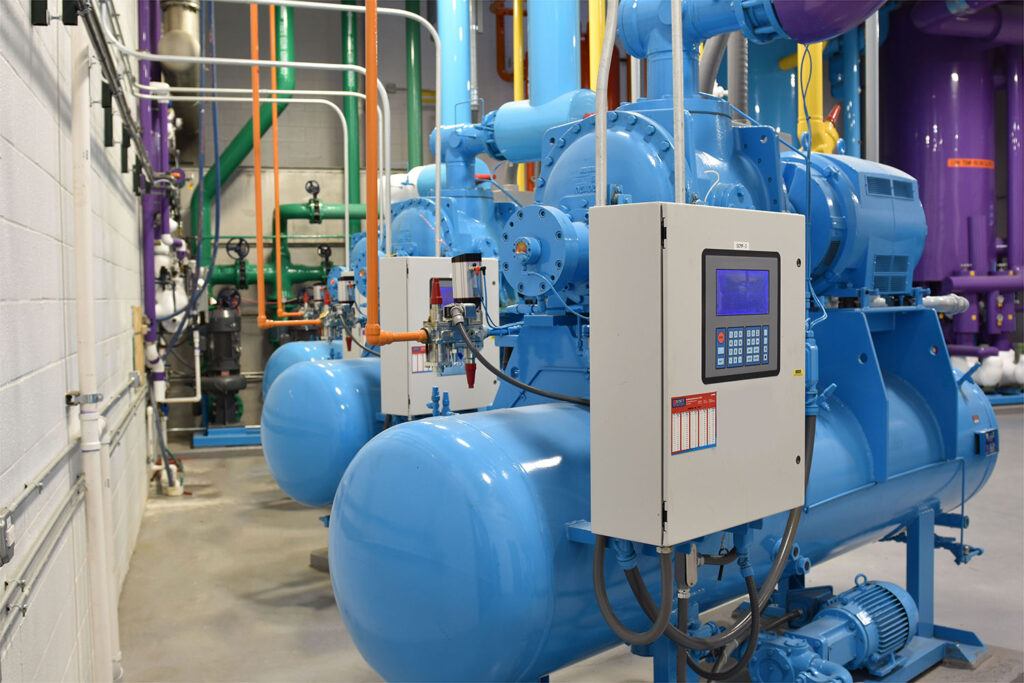Introduction
Ammonia Refrigeration System is a type of vapor compression refrigeration system that uses anhydrous ammonia (NH₃) as its working fluid. It’s predominantly chosen for large-capacity industrial applications because of its outstanding thermodynamic performance, eco-friendliness, and operational economy. This system plays a crucial role in sectors requiring continuous, reliable, and heavy-duty cooling, such as cold storage, food processing, dairies, breweries, chemical plants, and ice manufacturing. Refrigeration systems are the backbone of industries that rely on controlled temperature environments for production, preservation, and process stability. Among all available options, Ammonia Refrigeration Systems have stood the test of time as one of the most efficient, sustainable, and reliable refrigeration technologies for large-scale industrial applications.
Why Choose Ammonia Refrigeration?
The use of ammonia as a refrigerant offers multiple operational, environmental, and financial advantages over synthetic refrigerants like Freon-based compounds:
Thermodynamic Superiority
- High latent heat of vaporization (1370 kJ/kg at -33°C) — enabling more cooling per unit mass, reducing the refrigerant charge needed.
- Higher thermal conductivity than most common refrigerants, improving heat transfer efficiency.
- Operates effectively at relatively low pressures compared to its cooling capacity.
Environmental Responsibility
- Zero Ozone Depletion Potential (ODP)
- Zero Global Warming Potential (GWP)
- Fully natural refrigerant with no long-term environmental accumulation effects.
Economic Efficiency
- Lower operating costs due to high energy efficiency.
- Lower refrigerant cost and easy availability in most industrial markets.
- Longer equipment lifespan due to less chemical reactivity with metals like steel.
Working Principle: The Vapour Compression Cycle
An Ammonia Refrigeration System works on a closed-loop vapour compression cycle, comprising four main stages: compression, condensation, expansion, and evaporation.
Compression
Low-pressure, low-temperature ammonia vapor from the evaporator enters the compressor. Here, it’s compressed to a high-pressure, high-temperature state.
Condensation
The high-pressure vapor flows into a condenser where it rejects heat to air (air-cooled) or water (water-cooled), turning into a high-pressure liquid.
Expansion
The liquid ammonia passes through an expansion device (expansion valve or float valve) where it experiences a pressure drop, causing partial evaporation and a significant temperature drop.
Evaporation
The cold, low-pressure ammonia absorbs heat from the space or process medium in the evaporator, evaporating completely into a vapor and completing the cycle.
Major System Components
- Compressor – Typically reciprocating or screw type; compresses vapor and circulates refrigerant.
- Condenser – Heat exchanger where ammonia vapor releases heat and liquefies.
- Receiver – Collects and stores condensed ammonia liquid.
- Expansion Valve – Controls refrigerant flow into the evaporator.
- Evaporator – Transfers heat from the product/process to the refrigerant.
- Oil Separator – Removes lubricant from ammonia vapor.
- Liquid Separator – Prevents liquid slugging into compressors.
- Safety Valves – Protect system against overpressure situations.
- Pumps (in flooded systems) – Ensure proper refrigerant circulation.
Types of Ammonia Refrigeration Systems
- Direct Expansion (DX) System
Liquid ammonia expands in the evaporator and evaporates directly, cooling the process fluid or environment. - Flooded System
The evaporator remains filled with liquid ammonia; excess vapor returns to the compressor via a separator. - Recirculated Pump System
Circulates ammonia via pumps; ensures consistent ammonia supply in multiple evaporators. - Two-stage Compression Systems
Ideal for ultra-low temperature applications (-40°C and below) using an inter-stage economizer for efficiency.
Market Trends & Sustainability Factor
As governments globally impose restrictions on synthetic refrigerants with high ODP and GWP values (like R22, R404A), ammonia is experiencing a revival in popularity.
Technological improvements in low-charge ammonia systems reduce refrigerant quantities while retaining high capacity and safety.
Increasing demand for sustainable refrigeration.
Growth in cold chain logistics, food security infrastructure, and vaccine storage.
Conclusion
Ammonia Refrigeration Systems remain a cornerstone technology in industrial cooling, combining operational excellence, cost-efficiency, and environmental responsibility. Its unrivaled thermodynamic characteristics make it the most energy-efficient refrigerant for large-scale, continuous-duty applications. Despite the inherent handling challenges, modern engineering designs, automation, and advanced safety systems have significantly mitigated operational risks. Ammonia’s zero ODP and zero GWP credentials position it as an indispensable choice in today’s climate-conscious world. In industries where operational reliability, rapid cooling, and long-term sustainability are non-negotiable, ammonia refrigeration systems not only meet expectations but consistently exceed them.

